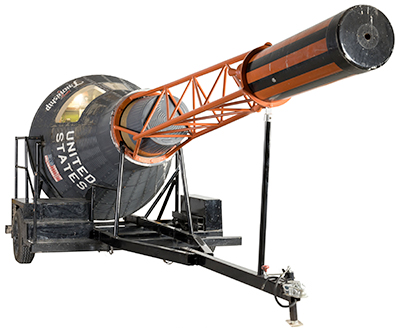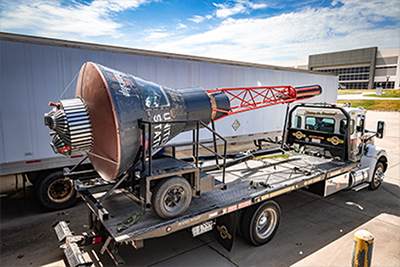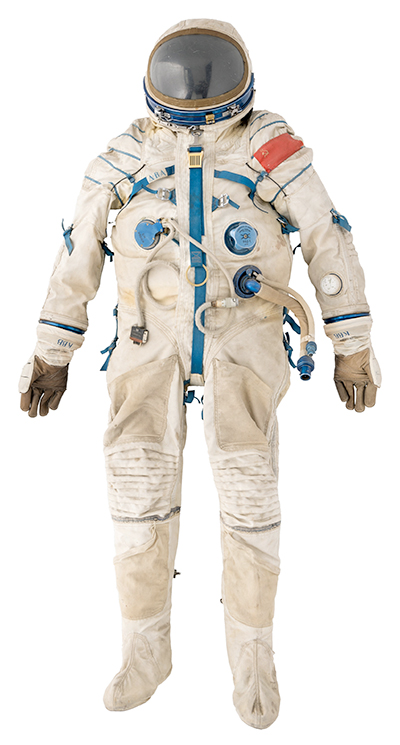The Right Stuff: 'Friendship 7' Model Made By Spacecraft's Official Manufacturer Touches Down in Heritage's Space Exploration AuctionApollo 11-flown fabric from Wright Flyer wing, cosmonaut spacesuit also among December 14-15 event's highlights
The then-Soviet Union launched Sputnik 1 in October 1957, an event that served as a metaphoric launching pad for the start of the space race.

The United States scrambled to catch up, approving Project Mercury the following year. The mission of the project was to pull the American space program even — or boost it beyond — its Russian counterpart, but that required the construction of a serviceable spacecraft. NASA quickly began conducting tests and working with assorted contractors to create one, ultimately landing on McDonnell Aircraft Corporation as its chosen vendor.
The only known Full-Scale McDonnell Aircraft Corporation Manufactured Friendship 7 Mercury Spacecraft Exhibition Model will soar into a new collection when it is sold in Heritage's Space Exploration Signature Auction December 14-15.
This out-of-this-world monument to the U.S. space program was donated in 1966 to the Boy Scouts of America, which eventually stored it with the Longhorn Council in Fort Worth. In a letter from the BSA to McDonnell, the aerodynamic spike at the end of the end of the rocket was declined because of space limitations.
The model is as impressive in size as it is in historical significance. With an exterior constructed primarily of machined metal, the capsule and escape tower measure approximately 23-1/2 feet in length, with a diameter of 6-1/3 feet.
"This absolutely is a once-in-a-lifetime opportunity to own an unbelievably important artifact in the history of the U.S. space program and of space travel in general," says Brad Palmer, Director of Space Exploration at Heritage Auctions. "When you're talking about a project as significant as creating a vessel that can travel — and return — safely to space, the amount of research and engineering involved is astronomical.
"Projects like this require an enormous amount of testing and numerous models during the construction phase, but this is the only model we have been able to locate anywhere. NASA, museums, in private hands ... we have not located anything like it anywhere, or even photos or records of a similar model."

The Mercury Project on which the 1983 movie The Right Stuff was based made the Mercury Seven — John Glenn, Scott Carpenter, Gordon Cooper, Gus Grissom, Wally Schirra, Alan Shepard and Deke Slayton — the first American astronauts. On February 29, 1962, Friendship 7 became the first American orbital spaceflight after two Russian orbital flights and two American sub-orbital flights. Friendship 7 was carried from Cape Canaveral, Florida into orbit by an Atlas LV-3B launch vehicle. After three orbital laps around the world, in a trip that lasted just under five hours, it re-entered the Earth's atmosphere, splashed down in the North Atlantic Ocean and was safely taken aboard U.S.S. Noa.
"That mission forever changed the American space program, and made those astronauts larger-than-life figures, heroes to an entire nation," Palmer said. "They helped a generation of kids start dreaming of growing up to become astronauts, hoping to explore whatever was beyond the clouds they saw in the sky and the stars they saw at night.
"Project Mercury was the program that jump-started a generation of curiosity and research, and it never would have gotten off the ground without this critically important capsule."
Running from 1958 through 1963, Project Mercury was an indisputable success, fulfilling its objectives of putting a man in orbit, studying space's effects on the human body, and successfully recovering both the astronaut and spacecraft. Beginning with Shepard's initial 15-minute flight on May 5, 1961, the flights became incrementally more ambitious. The Friendship 7 mission this exhibition model represents was an incredibly pivotal step in the program's evolution. This was the first manned flight launched by the Atlas rocket, replacing the Redstone rocket that launched both Mercury-Redstone 3 (Shepard's Freedom 7) and Mercury-Redstone 4 (Grissom's Liberty Bell 7). After Glenn piloted the first American orbital flight in 1962, the ensuing flights of the Mercury program were flown by Carpenter, Schirra and Cooper, respectively.
On May 25, 1961, President Kennedy addressed Congress requesting funding, saying, "this nation should commit itself to achieving the goal, before the decade is out, of landing a man on the Moon and returning him safely to the earth." NASA achieved that goal July 20, 1969, when astronauts Neil Armstrong and Buzz Aldrin landed the Apollo 11 Lunar Module Eagle on the lunar surface that would not have been possible without the pioneering Project Mercury trips. In fact, the first man to fly a Mercury capsule became a moonwalker himself: in 1971, Shepard was Commander of Apollo 14.
The term "museum-worthy" is sometimes overused, but seems almost insufficient when applied to this otherworldly model.
The closest known example is at The Museum of Flight in Seattle. That model was fabricated by Guard Lee Inc., in 1986, but pales in comparison to the model offered in this lot, as it appears not to have any interior components and is without the escape tower. On the model offered in this auction, which is constructed seemingly entirely with non-flight material for museum exhibition, some switches and buttons are functional, while other aspects are decal-like. The instrument panel partially lights up when plugged into the standard plug at the bottom of the model.
Also offered in the auction is another incredibly significant artifact of American flight: an Apollo 11 Lunar Module-Flown Section of the Wright Flyer's Wing Fabric, Position No. 162, Flown as Part of the First Successful Powered Controlled Flight in History at Kitty Hawk in 1903 as well as the First Manned Lunar Landing in 1969. Originally from The Armstrong Family Collection™, CAG Certified, the fragment of muslin cloth comes from the left wing of the Wright Brothers' 1903 Flyer, which carried Orville and Wilbur Wright on the first manned flight at Kitty Hawk, North Carolina. It also accompanied Armstrong to Tranquility Base — the name of the lunar landing site of Apollo 11, the first manned mission to the moon — meaning it was aboard the two most important flights in history. In a signed letter dated January 26, 1970 (and currently in the Smithsonian Air & Space Museum), Neil Armstrong wrote: "I certify that the wooden and fabric materials provided by the Air Force Museum were placed aboard Apollo XI and carried to the surface of the moon by the lunar module 'Eagle' on mankind's first lunar landing, July 20, 1969." Armstrong was allowed to retain a portion of the cloth and propeller pieces for his own personal collection.
One of only 12 authentic copies of the Apollo 14 Lunar Module Flown Exceedingly Rare Microform King James Bible, Serial Number 14-026, Encased in a Beautiful Reliquary Containing 24 Karat Gold and Embellished with Jewels, Thoroughly Provenanced, with a Steve Zarelli Letter of Authenticity was dual-certified by Apollo 14 Edgar Mitchell, the astronaut who landed it, and Rev. John Maxwell Stout, the NASA Chaplain who coordinated the landing. The reliquary is inscribed "First Lunar Bible, Feb 5, 1971, Apollo 14." It was one of only 100 microform King James Bibles taken to the lunar surface as part of an initiative by the Apollo Prayer League to honor Apollo 1 astronaut Ed. White II, who planned to carry one but died with the crew in a flash fire on the launch pad January 27, 1967.

Everyone who dressed up as an astronaut for Halloween will be fascinated by a Soviet Sokol K Pressurized Spacesuit, manufactured by NPP Zvezda. An early example of a Soviet "rescue" suit including helmet, avionics and gloves, it was made by NPP Zvezda for Soyuz cosmonauts. The suit was designed as a response to the Soyuz 11 disaster in 1971 — during reentry of the mission the capsule depressurized, killing the three-man crew, after which suits like this one were used on all subsequent missions. The suit is adorned on the left shoulder with a Soviet flag and on the right chest with initials "D.V.A." for Vladimir Dzhanibekov, one of the most decorated cosmonauts in history.
An Apollo 11 Flown Silver Robbins Medallion, Serial Number 128, Originally from the Personal Collection of Lunar Module Pilot Backup Fred Haise, with a signed letter of authenticity, was one of 450 flown aboard Apollo 11, the first manned moon landing, July 16-24, 1969, with crewmembers Neil Armstrong, Michael Collins and Buzz Aldrin. The obverse depicts Collins' early and original concept for the mission insignia with the eagle carrying an olive branch in its mouth. NASA thought the sharp, open talons of the eagle looked too "warlike" and the olive branch, representing peace, was moved to the claws. This is one of, if not the only, major official item that renders the insignia as it was meant to be by the astronaut designer. The reverse has the dates of the mission, surnames of the crew and the serial number.
A Rare Vintage Large 1/10 Scale Apollo Command Module Model in Original Wooden Case is a unique early representation of the Apollo Command module that was manufactured in the early 1960s, and features a cut-away view that gives a glimpse of three highly detailed seated astronauts in Mercury-era silver spacesuits, each of which is adorned with a NASA meatball patch, name tag and various harnesses and other components. The model stands 19 inches tall and has a 14-inch diameter at its base. Early vintage models like this rarely appear on the market.














